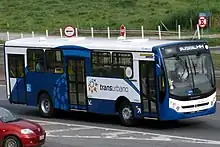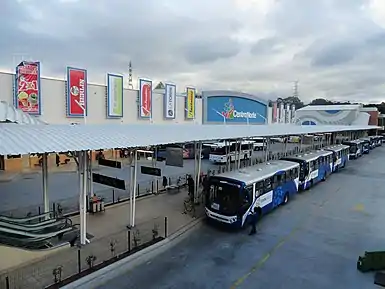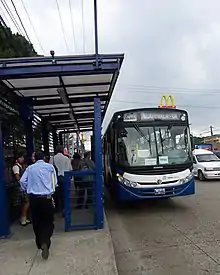Transurbano
The Transurbano is a public bus system that serves Guatemala City. The system is operated by Siga, and funded by the government of Guatemala. The project was inaugurated during the administration of ex-president Alvaro Colom, and was supported by the Asociación de Empresarios de Autobuses Urbanos (Association of Urban Bus Operators). The system was established with the goal of replacing privately operated bus service in Guatemala City, eventually amalgamating all urban bus services under the Transurbano umbrella. Service officially began on July 3, 2010, with 15 buses covering 3 routes operating in the southern part of the city between Zone 12 and Zone 21.[1]
| Transurbano | |
|---|---|
Logo | |
 Transurbano unit with wheelchair lift | |
| Overview | |
| Owner | SIGA, Private Sector (Partial rolling stock) |
| Locale | Guatemala City, Guatemala |
| Transit type | Local Bus |
| Number of lines | 41 |
| Daily ridership | 270,000 |
| Website | SIGA Transurbano |
| Operation | |
| Began operation | 3 July 2010 |
| Operator(s) | Sistema Integrado Guatemalteco de Autobuses (SIGA) |
| Number of vehicles | About 455 |
Phases
The system was launched in a series of phases, in order to manage rolling stock distribution and operations. Phase 1 was launched with services operating between Zones 12 and 21 in the southern part of the city. The system took advantage of the CENMA bus terminal to connect to Transmetro service. Phase 2 began shortly afterwards in February 2011. This phase provided more service to core areas of the city, including the historical downtown areas in Zone 1, Zone 2, and under served neighbourhoods in Zone 6, 17, 18, and 24. A majority of the bus drivers for the second phase were hired from private operators that were previously serving some of the target communities.[2] The second phase was further expanded, and complimented with express services between Zone 1 and northern neighbourhoods, after the opening of Centra Norte in Zone 17. Phase 3 serviced the neighbouring city of Mixo, with one route providing regular service between Zone 7 and Mixco. This route was eventually taken over from SIGA by the Mixco municipality as they began operations of their Rutas Express service.[3][4] Phase 4 was the last phase to start service and covered a number of under served zones, as well as provided local service connections to Transmetro Lines. This phase covers Zone 5, 13, and 15.[5] Since the end of Phase 4, the network has merely focused on its original goal of taking over privately operated service in the city, replacing it with transurbano rolling stock and fare payments.
Future operations
Due to the reduction in the gas subsidy for public transit operators, such as SIGA, various rolling stock owners and drivers have refused to provide service contracted by SIGA. Some have also chosen to raise fares or used cash instead of the SIGA smart card.[6] This has resulted in a system that is unreliable and comparable to the previously existing model of multiple companies operating several routes. Fully publicly operated systems such as Mixco's Rutas Express, Villa Nueva's TransMIO, and Guatemala's Transmetro have seen success at providing safe and reliable public service at an affordable price. In 2017, the municipality of Guatemala considered a proposal to create a new alternative transit system to the Transurbano, under the Transmetro banner.[7] This proposal would eventually develop into the TuBus system announced ahead of the 16th anniversary of Transmetro operations. This system is set to operate along a previously proposed Transmetro alignment between zone 17 and Centra Atlantida in zone 18, as well as zones 4, 6, 7, 9, and 14.[8]
Buses
The buses that made up the initial Transurbano fleet were made in Brazil by Busscar, Marcopolo, and CAIO. All buses featured informational LCD screens that displayed weather information and advertisements, security cameras, and GPS tracking. Since the completion of phase 4, SIGA has worked with private bus operators to convert and refurbish buses for Transurbano operation. Guatemala is a notable importer of decommissioned buses from the US. Historically, these have been decommissioned school buses that are transformed into chicken buses for rural passenger service.[9] However, private sector importers have begun importing decommissioned low-floor city buses from the US, which are then leased to SIGA for Transurbano operations. The addition of decommissioned low-floor buses and low-floor articulated buses has also resulted in greater accessibility for users in wheelchairs or with mobility issues, and addressed overcrowding.

Fare system
Fares are paid through a smart card, using RFID readers which deduct balance every time a user boards a bus. Fares initially were only GTQ1.10. However, the Asociación de Empresarios de Autobuses Urbanos (Association of Urban Bus Operators), who initially supported the Transurbano project, advocated for the end of subsidies for bus operations, which would allow them to increase bus fares in both privately run routes and Transurbano.[10][11] Fare increases must be approved by the government, and are closely monitored as a way to keep public transit relatively affordable, given there is no line transfer system, and instead users pay a fare every time they enter a vehicle. As of 2021, The smartcard for Transurbano is no longer accepted at Transmetro stations. Meaning riders must use SIGA cards for Transurbano, and Tarjeta Ciudadana (Citizen Card) for Transmetro.[12]
Routes
Southern Routes
The following is a list of routes that mainly serve the southern part of Guatemala City.
| Route Number | Destinations |
|---|---|
| 202 | USA–Santa Lucía–Zona 6 |
| 280 | Guajitos–Petapa–Trébol |
| 281 | Guajitos–Castellana–Terminal |
| 282 | Guajitos–Santa Cecilia–Centro–Parque |
| 283 | Justo Rufino Barrios–Obelisco |
| 284 | Justo Rufino Barrios–Venezuela–Castellana–Terminal |
| 285 | Justo Rufino Barrios–Venezuela–Santa Cecilia–Centro–Parque |
| 286 | Justo Rufino Barrios–Trébol |
| 287 | Justo Rufino Barrios–Santa Cecilia–Centro–Parque |
| 288 | Justo Rufino Barrios–Castellana–Terminal |
| 250 | Nimajuyú–Obelisco |
| 251 | Cerro Gordo–Nimajuyú–Santa Cecilia–Centro–Parque |
| 252 | Loma Blanca–Nimajuyú–Santa Cecilia–Centro–Parque |
| 253 | Loma Blanca–Nimajuyú–Castellana–Terminal |
| 254 | Ciudad Real–Santa Cecilia–Centro–Parque |
| 256 | Villa Hermosa–Trébol |
| 257 | Villa Hermosa–Terminal[13] |
| 256P | Prados Villa Hermosa–Trébol |
| 257P | Prados Villa Hermosa–Terminal |

Northern routes
The following is a list of routes that mainly serve the northern part of Guatemala City.
| Route Number | Destinations |
|---|---|
| 260 | Paraíso – Centro Oriente |
| 261 | Paraíso – Centro Occidente |
| 262 | Pinares del Norte – Centro |
| 263 | Pinares del Norte – Centro |
| 264 | Ilusiones – Kennedy – Centro |
| 265 | Ilusiones – Kennedy – Centro |
| 266 | Alameda – Centro 12 avenida |
| 268 | Alameda – Centro 10 avenida |
| 300 | El Limón – Atlántida – Centro |
| 301 | Maya – Centro |
| 302 | Maya – Centro |
| 305 | Prado – Atlántida |
| 306 | Canaán – Atlántida |
| 307 | Rosario – Atlántida |
| 309 | Lomas del Norte – Centro |
| 310P | Las Pilas – Centro |
| 310J | Cantón Jagüey – Centro |
| 311 | Los Ángeles – Centro |
| 311V | Centra Norte – Centro |
| 311O | Los Ocotes – Parroquia |
| 312 | El Chato, Llano Largo – Centro |
| 312F | Fiscal–Centro |
Santa Catarína Pínula
The following is a list of routes that mainly serve the town of Santa Catarina Pinula from Guatemala City.
| Route Number | Destinations |
|---|---|
| 110 | Santa Catarina Pinula – Terminal |
Avenida Reforma
The following is a list of routes that mainly serve a popular red-light district along the CA1 in Guatemala City.
| Route Number | Destinations |
|---|---|
| 250R | Avenida La Reforma – Tikal Futura |
Mixco (now Rutas Express)
| Route Number | Destinations |
|---|---|
| 76A | Colinas de minerva - Valle del sol |
Infrastructure
Bus stops are simple in construction, in order to allow for fast deployment of routes during the initial phases. A large station would consist of an illuminated sign with the Transurbano system logo, a metal fence facing the road, and a plastic translucent roof. Simpler bus stops were identified only by an illuminated sign on a blue metal pole. Starting February 2013, the municipality of Guatemala took responsibility for adjusting the locations and refurbishing Transurbano bus stops in the northern section of the system. Routes such as 263, 268, and 265 had some stations relocated as a result.[14] Major terminals like CENMA, Centra Norte, and Centra Atlantida are operated and maintained by the municipality of Guatemala.
Security
Security at bus stops consists of CCTV cameras, and an emergency intercom connected to a local police station. The original rolling stock also featured a GPS system for location tracking of each unit.[15] A women-only service was established in 2011 in order to prevent and reduce assaults on the system. The service was operated during rush hours only with specially designated units.[16]
Criticism
The system has faced numerous controversies that have had major impacts on its operations and have brought its effectiveness into question. According to passengers, the gates installed inside buses to prevent fare evasion on the initial units are too small, making it quite difficult for people with disabilities, overweight, or mobility devices to get through.[17] The introduction of the fare payment card was also quite controversial, as its deployment faced numerous challenges to getting information about where to get the card, and how to use it.[18] People with disabilities were also quite critical of the service, as it rolled out with conventional units requiring users to climb a set of stairs, and were not fitted with wheelchair lifts. This is despite the project's initial promise of removing accessibility barriers for public transit. Low-floor units were eventually introduced by contracting out some operations to private bus companies who imported decommissioned city buses from the U.S.[19] Additionally, senior citizens were promised free-fares. Initially throughout the day, then reduced to only during off-peak periods. However many contracted operators have refused to honour the complimentary service for seniors as part of disputes regarding fuel subsidies, leading the Human Rights Bureau to intervene begin enforcement on several routes.[20]
Corruption scandal
Dubbed the Caso Transurbano, the corruption scandal saw the eventual conviction of former president Álvaro Colom, a number of individuals who served as ministers during his administration, and former presidential candidate Manuel Baldizón.[21][22][23][24] Transurbano was originally presented as a Public–private partnership to create a transit system that would replace the unorganized services that were offered by a number of individual companies, by bringing all services under the Transurbano umbrella. This meant the government would contract out some operations, rolling stock, and maintenance to private operators while sharing a portion of the fare revenue. According to an investigation by the Public Ministry, working in collaboration with CICIG (International Commission against Impunity in Guatemala), it was determined that large sums of funds destined for the Transurbano project, and its operator SIGA, were funneled to various public officials and private contractors.[25][26] The funds were then used for the purchase of various luxury goods, including cars, cottages, and helicopters, as well as funding Baldizón's 2011 and 2015 presidential campaigns. in 2018 a judge handed various sentences and fines to eight people found guilty of various instances of money laundering and who were associated with those involved.[27] Ex-president Álvaro Colom was ordered to pay a GTQ 1 million bail, and was prohibited from exiting the country after an appeal for a jail sentence by the Public Ministry and CICIG was rejected. He remained under house arrest until his death in early 2023.[28][29] In 2022, a judge ruled that Baldizón would have to pay GTQ 1 million, and remain under house arrest after returning to Guatemala from serving a 28-month sentence in the U.S. for money laundering.[30]
Gallery
References
- "Transurbano inicia con inconvenientes (Transurbano starts with inconveniences)". 2010-07-06.
- "Transurbano empieza operaciones en julio de 2010 (Transurbano begins service in July 2010)". 2018-02-13.
- "Mixco impulsa proyecto dudoso de transporte público (Mixco launches a questionable public transit project)". 2017-01-05.
- "Presidente y su hijo inauguran eje de Transurbano en Mixco (President and his son inaugurate Transurbano phase in Mixco)". 2015-05-01.
- "Transurbano comienza a funcionar en Santa Catarina Pinula (Transurbano starts working in Santa Catarina Pinula)". 2014-04-29. Archived from the original on 2014-06-17.
- "Pilotos de Transurbano cobran pasaje en efectivo y rechazan tarjetas Siga". Retrieved 2023-03-27.
- "DIRECCIÓN DE MOVILIDAD URBANA" (PDF). Retrieved 2023-03-27.
- ""Tu Bus": el nuevo sistema de transporte que llegará en mayo a la ciudad". Retrieved 2023-03-27.
- "Old American School Buses Live a Second, Colorful Life in Guatemala". 2022-05-05.
- "Analizan alza a tarifa del pasaje (Fare hike to be discussed)". 2015-10-02.
- "Multa a Transurbano asciende a Q104 mil (Fines for Transurbano rise to 104-thousand Quetzales)". 2015-11-09.
- "Obtén tu Tarjeta Ciudadana en tan solo dos pasos". 2020-12-21. Retrieved 2023-01-09.
- "Aviso importante modificacion de rutas transurbano eje sur (Important notice of service changes to south Transurbano routes)". 2014-02-23. Archived from the original on 2014-02-23.
- "Modifican 7 paradas del transurbano". Archived from the original on 2013-02-08. Retrieved 2023-02-22.
- "Sistema de Control". Archived from the original on 2011-12-06. Retrieved 2023-02-22.
- "Buses para mujeres en Transurbano salen hoy". Archived from the original on 2011-08-04. Retrieved 2023-02-22.
- "Usuarios se quejan del Transurbano". Archived from the original on 2011-07-01. Retrieved 2023-02-24.
- "Transurbano comienza con tropiezos en colonia Alameda". Archived from the original on 2011-07-13. Retrieved 2023-02-24.
- "Grupos critican al Transurbano". Archived from the original on 2011-05-09. Retrieved 2023-02-24.
- "Mides informa que servicio de transporte público para los adultos mayores debe ser gratuito". Archived from the original on 2023-02-24. Retrieved 2023-02-24.
- "Álvaro Colom y varios exministros son capturados por caso Transurbano". Retrieved 2023-03-25.
- "Captura de Álvaro Colom llama la atención en medios de todo el mundo". Retrieved 2023-03-25.
- "Emiten otra orden de captura contra Alejandro Sinibaldi ahora por el caso Transurbano". Retrieved 2023-03-25.
- "Ligan a proceso a 18 personas por financiar al partido Líder". Retrieved 2023-03-25.
- "Revelan desvío de Q17.7 millones destinado a seguridad en transporte público". Retrieved 2023-03-25.
- "Declaran implicados en desvío de fondos del Transurbano para campañas de Manuel Baldizón". Retrieved 2023-03-25.
- "Ligan a proceso a ocho implicados más en caso Transurbano". Retrieved 2023-03-25.
- "Álvaro Colom saldrá de prisión por caso Transurbano". Retrieved 2023-03-25.
- "Fallece Álvaro Colom, expresidente de Guatemala, confirman fuentes allegadas a la familia". Retrieved 2023-03-27.
- "Manuel Baldizón deberá pagar Q1 millón por caso Transurbano". Retrieved 2023-03-25.






